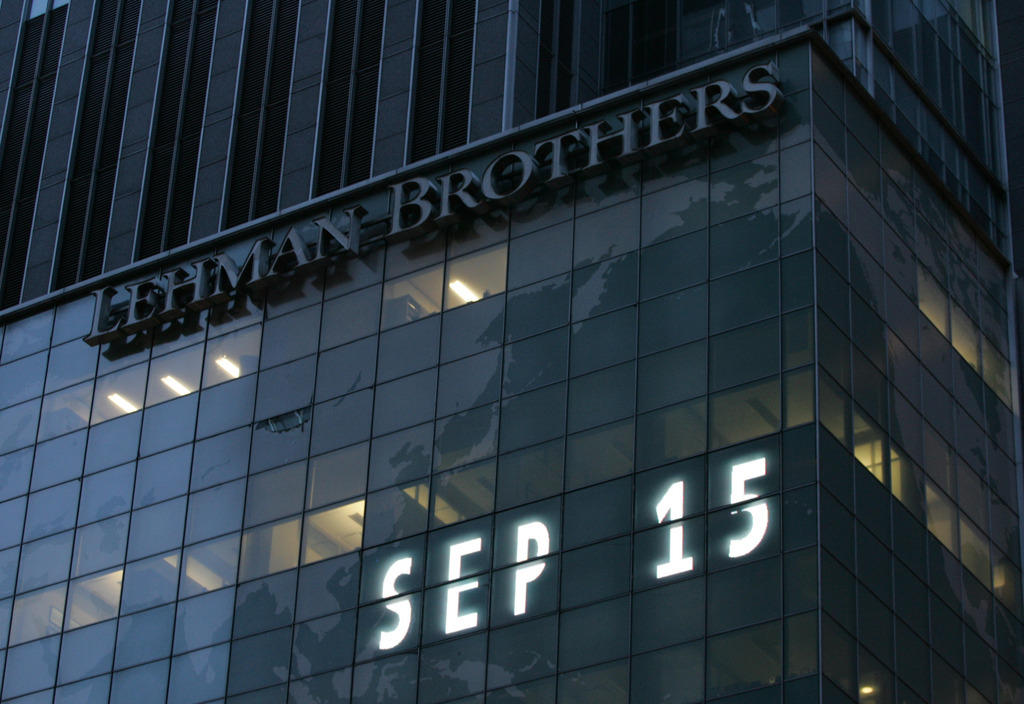
The financial crisis of 2008 and the Swiss ‘miracle’

The collapse of Lehman Brothers ten years ago triggered one of the biggest financial and economic crisis in a century. Switzerland did not escape unscathed but fared better than other countries, without amassing huge debt.

More
Lehman Brothers: the bankruptcy of a bank and that of a system
On September 15, 2008, the fourth largest US investment bank filed for bankrupcy over the crisis in the subprime mortgage market. The government refused to bail out the insolvent institution, creating a collapse in confidence that froze credit markets and decimated the banking sector. From the United States, the financial crisis spread to other countries, soon turning into a global economic crisis that raised the spectre of another Great Depression.
Switzerland was also affected but not as badly as initially feared.
Several reasons rendered Switzerland particularly vulnerable over the course of the crisis. Its top two banks, UBS and Credit Suisse, were among the most exposed foreign institutions in the subprime bubble. Switzerland was more dependent than other countries on the banking sector, which still accounts for more than 10% of gross domestic product (GDP). In 2008, the Swiss economy was barely recovering from a period of economic growth defined as anaemic. The crisis hit the US and the EU, Switzerland’s main economic partners, the hardest.
Making matters worse, the fall in the dollar and the outbreak of the crisis in the eurozone again pushed the Swiss franc upwards, causing prices for export goods to rise sharply. In 2011, the Swiss National Bank (SNB) was thus forced to introduce a minimum exchange rate threshold of CHF 1.2 for one euro, which was abandoned in 2015. This, together with the SNB’s further interventions in the foreign exchange and interest rate markets, made it possible to partially contain the upsurge in the Swiss franc.
The minimum exchange rate threshold, which was criticised both when it was introduced and when it was revoked, proved to be quite helpful in terms of restoring profit margins to export companies in the most sensitive period of the crisis. Living with a strong franc and a narrow domestic market, Swiss companies have long specialised in high quality products and niche markets. As a result, Switzerland sank less into recession than other countries in 2009 and regained decent growth rates more quickly. It should be noted, however, that after the abolition of the minimum exchange rate threshold in 2015, GDP growth weakened again.
Switzerland has also known how to harness the major measures taken by the US and Europe central banks to the benefit of its economy. EU members and the US account for almost 70% of Switzerland’s exports.
In comparison to many other countries, Switzerland has pulled off a small “miracle” by managing to overcome the crisis without accumulating colossal debts. On the contrary, in the last decade the state has even reduced its debt level, continuously securing billions in profits – with the exception of a mini deficit in 2014.
At a cost of several trillion dollars and euros, the bank rescue and economic recovery plans implemented by the US administration and European governments have left behind a mountain of debt, which is likely to collapse in the next economic crisis.
The excellent state of health of the Swiss public purse during this crisis is attributed to a number of factors. These include a low share of government expenditure compared with other countries, which are burdened by a heavy administrative system; the resilience of various economic sectors, which have ensured good tax revenues; and structural conditions that are attractive to foreign companies. The solidity of the Swiss economy 10 years after the start of the crisis is also reflected in the high level of public and private investment. Switzerland is one of the very few European countries to have achieved a higher level of investment in 2017 than in 2007.
However, Switzerland also paid the price for the crisis. One of the sectors most affected is the financial sector itself, which has been reduced in size internationally. In addition, the SNB was forced to massively increase its foreign exchange reserves, which is perhaps the main source of concern for the future. The central bank’s margin of manoeuvre to limit a new appreciation of the Swiss franc during the next crisis has been dangerously reduced.
Translated from Italian by Dominique Soguel

In compliance with the JTI standards
More: SWI swissinfo.ch certified by the Journalism Trust Initiative































You can find an overview of ongoing debates with our journalists here . Please join us!
If you want to start a conversation about a topic raised in this article or want to report factual errors, email us at english@swissinfo.ch.